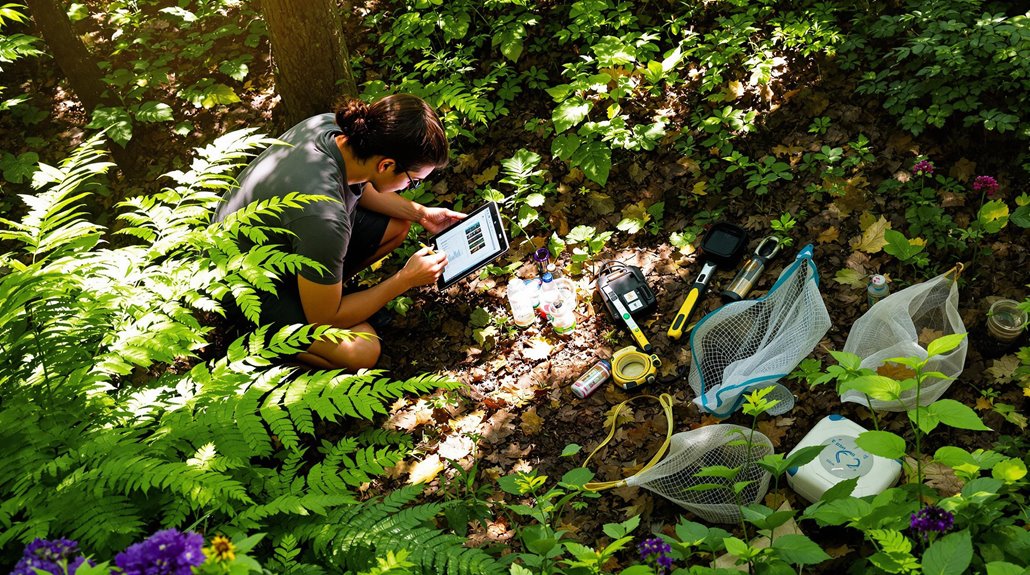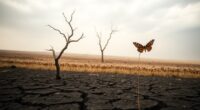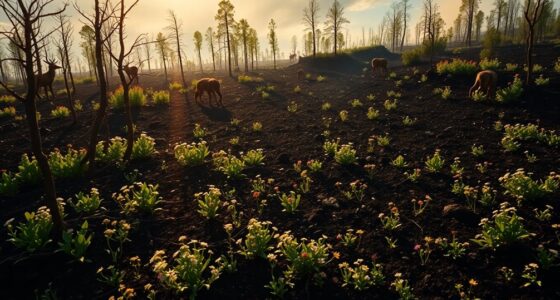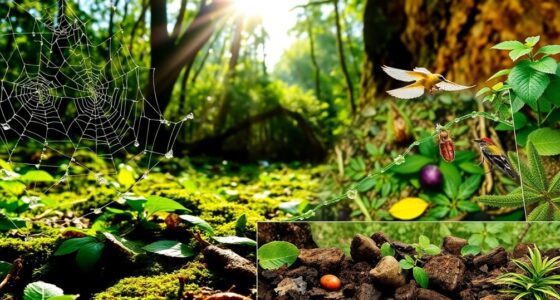To measure biodiversity, you'll want to use a mix of quantitative indices, innovative technologies, and effective data collection methods. Start with species richness and evenness indices to assess species diversity and distribution. Incorporate remote sensing techniques like satellite imaging and drones for large-scale monitoring. Field observations and tools like camera traps and acoustic sensors can enhance data collection on wildlife behaviors. Each method you choose reveals different aspects of ecological health and species interactions, providing a fuller picture of biodiversity. Discovering how these tools enhance your understanding offers even deeper insights into ecosystems' complexities.
Key Takeaways
- Utilize species richness indices to quantify the number of different species present in a community for biodiversity assessment.
- Apply evenness indices to evaluate the distribution of individuals across species, highlighting the importance of rare species.
- Implement remote sensing techniques, such as satellite imagery, to monitor large-scale biodiversity changes and identify hotspots.
- Collect data through various methods, including field observations, camera traps, and acoustic sensors, to gather insights on species behaviors and populations.
- Integrate citizen science platforms like iNaturalist to enhance community involvement and data collection for biodiversity assessments.
Understanding Biodiversity Indices

Biodiversity indices serve as essential tools for measuring the variety and distribution of life within ecosystems. When you consider species richness indices, you're looking at how many different species exist in a community. For instance, Margalef's and Menhinick's diversity indices help you account for sample size. However, keep in mind that species richness is heavily influenced by sampling size efforts.
On the other hand, evenness indices provide insights into the distribution of individuals across species. Pielou's and Shannon-Wiener indices are commonly used to gauge this aspect. Finally, taxonomic indices reveal evolutionary relationships within a community, offering deeper ecological understanding. Each index serves a unique purpose, enhancing your grasp of biodiversity's complexities.
Quantifying Biodiversity

Measuring biodiversity is essential for understanding the health of ecosystems and the relationships between species. To quantify biodiversity, you can use various indices. Species richness indices, like Margalef's and Menhinick's, measure the number of species in a community, but they depend heavily on sampling size. Evenness indices, such as Simpson's Diversity Index, assess how evenly individuals are distributed among species, highlighting the significance of rare species in disrupted habitats. Taxonomic indices offer insights into evolutionary relationships, while functional diversity focuses on biological traits within a community. Integrating these measures provides a thorough view, helping you appreciate the intricacies of biodiversity and its critical role in ecological processes, with various academic and industry methods available to assess biodiversity tools.
Remote Sensing Techniques

Remote sensing techniques play an essential role in evaluating and monitoring biodiversity across various ecosystems. You can utilize direct remote sensing methods like imaging spectrometry to gather data on plant characteristics by measuring light reflectance. Satellite-based imaging, developed by organizations like ESA and NASA, allows you to capture images of the Earth every 16 days with a pixel size of 30×30 meters. Effective identification of biodiversity hotspots aids in prioritizing conservation efforts. Indirect remote sensing helps estimate biodiversity using environmental parameters, such as land-cover changes. By applying the spectral diversity hypothesis, you can assess spatial heterogeneity, which relates to species richness. Future satellite missions, like EnMap and PRISMA, promise to enhance monitoring capabilities, enabling you to better understand ecological dynamics and conserve biodiversity effectively.
Data Collection Methods

When studying ecosystems, it's crucial to employ a variety of data collection methods to capture a detailed picture of biodiversity.
Start with field observations, where trained scientists and volunteers gather qualitative data on species behaviors, populations, and environmental conditions. Camera traps help discreetly monitor elusive wildlife, while acoustic sensors capture vocalizations to identify species and observe population trends. Additionally, satellite imagery provides large-scale landscape and habitat data, enabling the tracking of changes over time.
For large-scale assessments, satellite imagery provides insights into habitat changes over time. Additionally, radio and GPS tracking enables you to understand animal movements and migration patterns.
Finally, drones offer a bird's-eye view of remote areas, allowing for efficient data collection without disturbing the environment. These methods work together to give you a thorough understanding of biodiversity.
Techniques for Various Ecosystems

Understanding biodiversity requires tailored techniques for different ecosystems, as each environment presents unique challenges and opportunities.
In forest ecosystems, you might use quadrat and transect sampling to assess species distribution, alongside point-count methods for birds. Species richness is often used as a preliminary indicator of ecosystem health in these areas.
For grasslands, consider the mark-recapture method to estimate animal populations, while species richness and evenness help you understand community structure.
In marine ecosystems, acoustic surveys and camera traps provide insights into species presence, while genetic sampling reveals population dynamics.
For freshwater environments, electrofishing and netting allow you to sample fish, and water quality monitoring helps gauge ecosystem health.
Each technique enriches your understanding, ensuring effective conservation strategies tailored to specific ecosystem needs.
Biodiversity Assessment Frameworks

Effective biodiversity assessment relies on structured frameworks that adapt to various contexts. One approach is the Customized Hierarchical Urban Habitat Classification, which combines physical and anthropogenic factors to differentiate habitat types in urban landscapes. By integrating citizen science-generated data, like iNaturalist and eBird, you can analyze species distributions across these habitats with minimal taxonomic expertise. For financial institutions, tools like ENCORE and IBAT provide sector and location-specific assessments, helping you understand biodiversity dependencies and impacts. Furthermore, urban biodiversity in cities enhances public engagement with nature, emphasizing the importance of these assessments. Finally, frameworks for biodiversity monitoring utilize science-based protocols to guarantee credible assessments, linking biological sampling to management objectives. This thorough approach supports effective communication and adaptive management, enabling you to make informed decisions for biodiversity conservation.
Frequently Asked Questions
What Are the Main Threats to Biodiversity Today?
Today, you'll find that biodiversity faces several significant threats. Climate change alters ecosystems and increases extreme weather events, while pollution—both air and water—continues to harm countless species.
Habitat loss from deforestation and urbanization disrupts natural environments. Additionally, invasive species outcompete native ones, leading to their decline.
Together, these factors create a challenging landscape for biodiversity, making it essential for you to be aware and take action to help preserve it.
How Does Climate Change Impact Biodiversity?
Climate change isn't just a little hiccup; it's a freight train barreling down on biodiversity!
You'll notice increased storms, fires, and droughts wreaking havoc on habitats, pushing species to the brink. As temperatures rise, ecosystems shift, and organisms scramble to survive.
Many face extinction, with harsh projections showing up to 30% at risk by century's end. It's a race against time, and every action you take can make a difference.
What Role Do Invasive Species Play in Biodiversity Loss?
Invasive species play a significant role in biodiversity loss by outcompeting native species for resources, introducing diseases, and altering habitats.
You'll notice that these invaders can cause severe ecological disruptions, especially in vulnerable ecosystems like islands.
As these species thrive, they threaten the unique flora and fauna, leading to extinctions.
Understanding their impact helps you appreciate the urgency of conserving native biodiversity and managing invasive populations effectively.
How Can Individuals Contribute to Biodiversity Conservation?
You can contribute to biodiversity conservation in several impactful ways.
Start by educating yourself about local ecosystems and sharing that knowledge within your community.
Reduce waste and choose eco-friendly products to minimize your ecological footprint.
Participate in local conservation projects or community gardens to restore habitats.
Advocate for policies that protect biodiversity and support organizations working towards these goals.
Every small action you take can make a significant difference for our planet's diverse life.
What Are the Economic Benefits of Preserving Biodiversity?
Think of biodiversity as the backbone of our planet's economy. By preserving it, you're not just protecting nature; you're avoiding legal headaches and boosting your brand's reputation.
Compliance with biodiversity regulations can streamline your project approvals and minimize risks in your supply chain.
Plus, when you commit to conservation, you attract eco-conscious consumers, enhancing customer loyalty and market differentiation.
Ultimately, investing in biodiversity guarantees long-term sustainability and innovation for your business.
Conclusion
In a world echoing the themes of "Silent Spring," measuring biodiversity has never been more essential. By employing various tools and techniques—from remote sensing to diverse ecosystem assessments—you can reveal the hidden patterns of life around you. As you engage with these methods, remember that every data point is a brushstroke in the larger masterpiece of our planet's health. By taking action now, you're not just observing biodiversity; you're safeguarding it for future generations.









